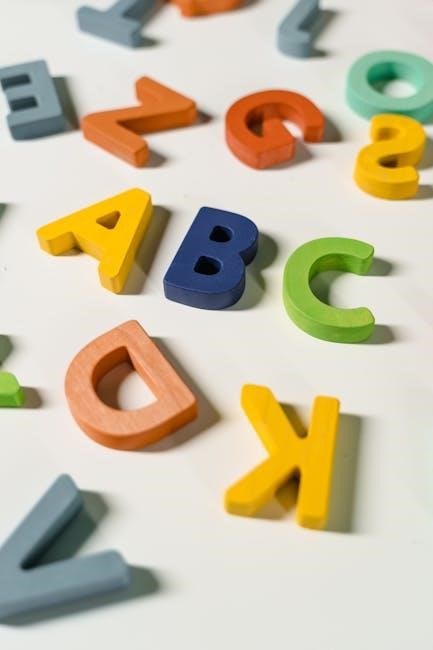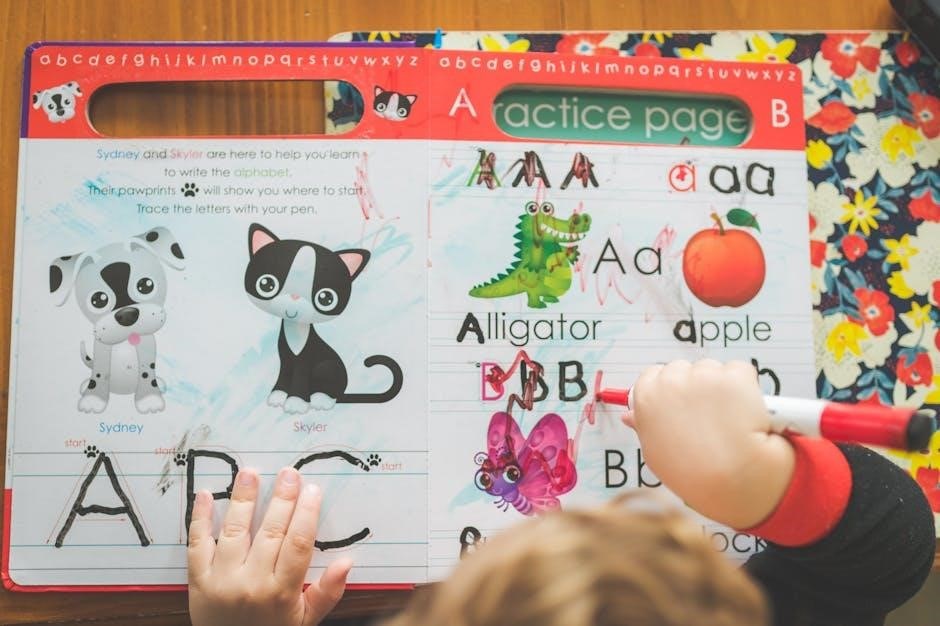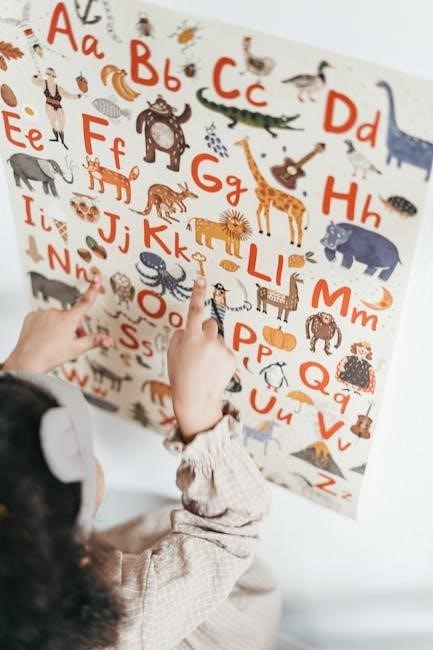An engaging tool for mastering the alphabet, the Alphabet Workbook PDF offers a comprehensive guide with tracing pages, colorful illustrations, and interactive exercises․ Designed for young learners, it combines fun and education, making it perfect for preschoolers and ESL students․ The workbook includes uppercase and lowercase letters, word formation, and puzzles, fostering letter recognition and handwriting skills․ Its structured format ensures progressive learning, while vibrant designs keep children motivated․ Available in various themes, it adapts to different learning styles, providing a solid foundation for early literacy․
Overview of Alphabet Workbooks
Alphabet workbooks are educational resources designed to help young learners master the basics of the alphabet․ These workbooks typically include tracing pages, coloring activities, and interactive exercises․ They often feature uppercase and lowercase letters, along with phonics-based content to enhance learning․ Many workbooks incorporate vibrant illustrations and engaging designs to keep children motivated․ Some also include word formation exercises and puzzles to reinforce letter recognition and early reading skills․ These tools are widely used in preschools and by ESL learners, offering a structured approach to alphabet mastery․ They are available in various formats, including themed editions for added fun․
Importance of Learning the Alphabet
Learning the alphabet is the foundation of literacy, enabling children to recognize and understand letters, sounds, and word formation; It enhances reading and writing skills, fostering early communication abilities․ Tracing and practicing letters helps develop fine motor skills and handwriting․ Interactive exercises and colorful designs in workbooks make learning engaging and fun, fostering a love for reading․ Alphabet mastery builds confidence and prepares young learners for more complex academic tasks․ It is essential for cognitive development and serves as the starting point for a lifelong journey of learning and exploration․
Target Audience for Alphabet Workbooks
Alphabet workbooks are primarily designed for preschoolers and kindergartners beginning their literacy journey․ They are also beneficial for ESL learners adapting to the Latin script and children with learning disabilities․ Parents and educators seeking structured, engaging tools for teaching the alphabet will find these workbooks invaluable․ The interactive exercises and colorful designs cater to young learners’ attention spans, while the progressive difficulty ensures a smooth transition from letter recognition to word formation․ These resources are ideal for fostering early literacy skills in a fun and accessible manner, making them a versatile tool for various learning needs․

Key Features of Alphabet Workbook PDF
Alphabet Workbook PDFs include uppercase and lowercase letters, tracing activities, colorful illustrations, and interactive exercises․ They offer engaging designs and structured practice sheets for effective learning․
Uppercase and Lowercase Letters
Alphabet workbooks emphasize both uppercase and lowercase letters, providing clear distinction and practice opportunities․ Activities include tracing, writing, and matching games to enhance recognition and differentiation․ Colorful illustrations and engaging layouts help learners understand letterforms․ Many workbooks also incorporate real-life examples, such as words starting with each letter, to reinforce memorization․ This dual focus ensures learners gain proficiency in identifying and reproducing letters accurately, building a strong foundation for reading and writing skills․ The structured approach makes learning letters enjoyable and systematic for young learners․
Tracing Activities for Letter Practice
Tracing activities are a cornerstone of alphabet workbooks, offering hands-on practice for letter formation․ These exercises feature directional arrows to guide learners in replicating uppercase and lowercase letters accurately․ Workbooks often include tracing pages with letters, words, and simple sentences, helping develop fine motor skills and handwriting precision․ Interactive tracing exercises, paired with fun illustrations, engage young learners and make practice enjoyable․ Tools like dabbing or coloring letters further enhance tactile learning, ensuring a memorable experience․ Regular tracing practice builds confidence and mastery of letter shapes, essential for early literacy development․
Colorful Illustrations and Engaging Designs
Alphabet workbooks are enriched with vibrant illustrations and engaging designs to captivate young learners․ These visuals, such as cute characters and themed artwork, make letter recognition and practice enjoyable․ Many workbooks incorporate cultural or regional elements, adding relatability and diversity․ The colorful layouts and creative designs help maintain children’s interest, transforming learning into a fun experience․ Interactive elements, like tracing activities with illustrations, enhance the educational process․ These engaging visuals not only aid in letter memorization but also foster a positive attitude toward learning, making the workbook an effective tool for early literacy development․
Interactive Exercises and Puzzles
Alphabet workbooks feature a variety of interactive exercises and puzzles to keep young learners engaged․ These include tracing pages with directional arrows, word formation exercises, and matching activities․ Puzzles like mazes and letter-based games challenge children to think critically while practicing their alphabet skills․ Interactive elements such as “dab the letter” activities encourage hands-on participation, making learning fun․ These exercises not only improve letter recognition but also enhance problem-solving abilities․ By integrating play with education, these workbooks create a dynamic and enjoyable learning environment for children to master the alphabet effectively․

Benefits of Using Alphabet Workbook PDF
Alphabet workbooks enhance early literacy by improving letter recognition, handwriting, and fine motor skills․ They foster confidence in young learners, providing a strong foundation for reading and writing․
Improved Handwriting Skills
Alphabet workbooks provide structured tracing activities, guiding young learners to form letters accurately․ Practice sheets with directional arrows help develop muscle memory, enhancing handwriting quality․ The repetitive nature of tracing exercises ensures mastery of both uppercase and lowercase letters․ Colorful illustrations and engaging designs keep children motivated, making the learning process enjoyable․ These workbooks are particularly beneficial for preschoolers and ESL students, offering a clear path to improving handwriting skills through consistent practice and interactive exercises․
Enhanced Letter Recognition
Alphabet workbooks are designed to enhance letter recognition through interactive exercises and visual aids․ Tracing activities and letter-matching games help children identify and memorize letter shapes․ The workbooks often include colorful illustrations and themed worksheets, making learning engaging․ Repetitive practice reinforces letter recognition, while puzzles and word formation exercises connect letters to sounds․ These resources are particularly effective for young learners, helping them distinguish between similar letters and build a strong foundation for reading and writing skills․ The structured approach ensures steady progress in recognizing both uppercase and lowercase letters․
Development of Fine Motor Skills
Alphabet workbooks play a significant role in developing fine motor skills through tracing and writing exercises․ Activities like tracing uppercase and lowercase letters help strengthen hand muscles and improve dexterity․ Coloring tasks and interactive puzzles also enhance coordination and precision․ Repetitive practice allows children to master letter formation, while games like dabbing letters provide fun ways to refine motor control․ These exercises are particularly beneficial for preschoolers, as they prepare their hands for more complex writing tasks․ The structured approach ensures steady improvement in fine motor abilities, laying a strong foundation for future academic success․
Fun and Interactive Learning Experience
Alphabet workbooks are designed to make learning enjoyable and engaging for young learners․ Interactive exercises, such as puzzles, mazes, and coloring pages, create a dynamic learning environment․ These activities not only teach letter recognition but also keep children motivated and entertained․ Games like matching uppercase and lowercase letters or identifying sounds add an element of fun, making the learning process feel like play․ The combination of visual and hands-on tasks ensures that children stay focused and develop a love for learning the alphabet in a stress-free and enjoyable way․

Structure of a Typical Alphabet Workbook PDF
A typical workbook includes introduction pages, letter-by-letter practice sheets, word formation exercises, and review pages; It progresses from tracing letters to forming simple words, ensuring a logical learning flow․
Letter-by-Letter Practice Sheets
Letter-by-letter practice sheets in an alphabet workbook PDF provide focused exercises for each letter, helping children master uppercase and lowercase forms․ These sheets often include tracing activities, with arrows guiding proper letter formation․ They may also feature matching games, where children link letters to corresponding objects or sounds․ Interactive elements, such as “dab the letter” activities, encourage engagement․ Each sheet typically progresses from tracing to independent writing, reinforcing muscle memory and letter recognition․ Visuals and simple instructions make these pages accessible for young learners, ensuring a clear and effective learning experience tailored to individual progress․
Word Formation Exercises
Word formation exercises in an alphabet workbook PDF help children transition from letter recognition to creating simple words․ These exercises often involve sequencing letters, matching sounds, and filling in missing letters to complete words․ Activities may include connecting letters to form basic vocabulary, such as “cat” or “dog,” and associating words with corresponding images․ Some workbooks introduce blending sounds to decode words, while others focus on building confidence in spelling short, familiar words․ These exercises bridge the gap between letter practice and early reading skills, fostering phonetic awareness and creativity in language learning․ They are designed to be both educational and enjoyable, ensuring a smooth progression in literacy development;
Review and Assessment Pages
Review and assessment pages in an alphabet workbook PDF are crucial for reinforcing learning and identifying progress․ These pages typically include activities like matching uppercase and lowercase letters, identifying letters in words, and completing simple sentences․ Assessments may involve tracing previously learned letters or recognizing letters in random sequences․ Some workbooks incorporate puzzles or word searches as fun ways to evaluate understanding․ These sections help track a child’s mastery of the alphabet, ensuring they are ready to move on to more complex skills․ They also provide teachers or parents with insights into areas that may need additional practice, fostering a personalized learning experience and solidifying foundational literacy skills․ Regular reviews and assessments ensure a strong grasp of the alphabet, laying the groundwork for successful reading and writing abilities․ They are essential for monitoring progress and celebrating milestones in a child’s educational journey․

Popular Types of Alphabet Workbook PDF
Alphabet workbooks come in various formats, including tracing workbooks, coloring and activity books, phonics-based workbooks, and interactive puzzle books․ Each type caters to different learning preferences, ensuring engaging and effective alphabet mastery for young learners․
Tracing Workbooks
Tracing workbooks are essential tools for early learners, focusing on letter formation through guided tracing activities․ These workbooks often feature large, clear fonts with directional arrows, helping children understand stroke order․ They include exercises for both uppercase and lowercase letters, with spaces for repeated practice․ Some tracing workbooks incorporate mazes, puzzles, and connect-the-dot activities to make learning interactive․ Suitable for preschoolers and beginners, tracing workbooks enhance fine motor skills and handwriting․ They also cater to ESL learners and those with learning challenges, offering a structured approach to mastering the alphabet effectively and confidently․
Coloring and Activity Books
Coloring and activity books combine vibrant visuals with engaging tasks to make learning the alphabet enjoyable․ These books feature illustrations of objects starting with specific letters, allowing children to associate sounds with visuals․ Activities include coloring pages, mazes, and puzzles that reinforce letter recognition․ Many designs incorporate themes like animals or seasons to captivate young learners․ These books also often include tracing exercises, blending learning with creativity․ They are ideal for preschoolers, fostering both cognitive development and artistic expression while maintaining educational value and fun․
Phonics-Based Workbooks
Phonics-based workbooks focus on connecting sounds to letters, helping learners recognize and pronounce words effectively․ These books often include exercises like tracing letters, matching sounds to objects, and forming simple words․ They emphasize the relationship between letters and their sounds, making learning interactive and systematic․ Many phonics workbooks incorporate short paragraphs and engaging visuals to reinforce learning․ Activities are designed to build foundational reading skills, ensuring learners progress from letter recognition to word formation seamlessly․ These workbooks are particularly effective for early readers and ESL students, providing a structured approach to mastering phonics․
Interactive Puzzle Books
Interactive puzzle books are designed to make learning the alphabet an enjoyable and engaging experience․ These workbooks often include activities like matching games, crossword puzzles, and word searches․ Learners can match uppercase and lowercase letters, identify letters in words, or complete simple puzzles to reinforce their understanding; Many puzzle books feature colorful visuals and playful characters to keep young learners entertained․ These activities not only improve letter recognition but also enhance problem-solving skills and memory․ Interactive puzzle books are ideal for children who thrive on hands-on, playful learning experiences, making the alphabet learning process both fun and effective․

How to Use Alphabet Workbook PDF Effectively
Start with step-by-step tracing guides to help learners form letters correctly․ Encourage repetitive practice for mastery․ Use audio and visual aids to enhance engagement․ Involve parents or teachers for guidance and support, ensuring consistent progress and understanding․
Step-by-Step Tracing Guides
Step-by-step tracing guides in the Alphabet Workbook PDF provide clear instructions for forming letters accurately․ Each guide includes directional arrows and numbered strokes, helping learners understand the proper sequence․ These tools are especially beneficial for young children, as they develop fine motor skills and handwriting abilities․ Tracing exercises are often paired with visual cues, such as dashed lines and bold examples, to make learning intuitive․ Regular practice with these guides ensures mastery of letter formation, building confidence and a strong foundation for reading and writing․ They are ideal for both independent practice and guided sessions with educators or parents․
Repetitive Practice for Mastery
Repetitive practice is a cornerstone of the Alphabet Workbook PDF, helping learners master letter formation and recognition through consistent effort․ By tracing letters multiple times, children develop muscle memory and improve handwriting accuracy․ The workbook includes dedicated pages for repeated tracing of uppercase and lowercase letters, ensuring fluency and consistency․ Regular practice also enhances letter recognition, a critical skill for early literacy․ These exercises are designed to be engaging, with themed worksheets that maintain interest and motivation․ Over time, repetitive practice builds confidence, leading to mastery of the alphabet and a strong foundation for reading and writing skills․
Incorporating Audio and Visual Aids
Incorporating audio and visual aids enhances the learning experience in the Alphabet Workbook PDF, making it more engaging and effective․ Audio features, such as letter sounds and phonetics, help learners associate visuals with correct pronunciation․ Visual aids like animations, videos, and images provide context and make concepts memorable․ These multimedia elements cater to different learning styles, ensuring that visual, auditory, and kinesthetic learners benefit equally․ The combination of audio and visuals creates an immersive environment, fostering better retention and understanding of alphabet concepts․ This approach also makes learning fun and accessible for young children and those with diverse learning needs․
Parental or Teacher Involvement
Parental or teacher involvement is crucial for maximizing the benefits of the Alphabet Workbook PDF․ Educators and caregivers can guide young learners through tracing activities, offer feedback on letter formation, and encourage repetition for mastery․ Their support helps clarify concepts, correct mistakes, and build confidence․ Interactive exercises and puzzles within the workbook are more effective when done collaboratively, fostering a sense of achievement․ This involvement also allows for personalized learning, ensuring that each child progresses at their own pace while staying motivated and engaged in the learning process․

Resources for Downloading Alphabet Workbook PDF
Alphabet Workbook PDFs are available on educational websites, offering free printable worksheets and activities․ Teacher-designed materials provide structured lessons, while paid premium workbooks offer advanced features․ Additionally, platforms like OZON and Macmillan Education supply diverse resources, ensuring accessibility for various learning needs and preferences․
Free Printable Worksheets Online
Free printable worksheets online offer a variety of alphabet learning resources, including tracing pages, coloring books, and interactive puzzles․ Websites provide PDF downloads like ABC workbook․pdf and AlphabetPuzzles-uppercase․pdf, designed for preschoolers and ESL learners․ These worksheets feature engaging activities such as letter tracing, word formation, and matching games․ They are ideal for developing letter recognition and handwriting skills․ Platforms like Macmillan Education and Teacher-Designed Materials offer structured lessons, while family_and_friends_alphabet_book․pdf includes cultural themes․ These free resources are easily accessible, making them a great starting point for early literacy development․
Educational Websites
Educational websites like Macmillan Education and others offer a wide range of alphabet workbooks and resources․ These platforms provide structured lessons, interactive exercises, and colorful illustrations to engage young learners․ Resources such as My alphabet book․pdf and family_and_friends_alphabet_book․pdf are popular choices, featuring tracing pages, word formation, and cultural themes․ They cater to preschoolers, ESL learners, and early literacy development․ These websites often include free downloads, making high-quality educational materials accessible to parents and teachers․ Their comprehensive guides and engaging designs make learning the alphabet fun and effective․
From the conversation history, I see that the user initially asked for information on the internet about alphabet workbooks and received a response listing various PDF files and their details․ Then, the user asked for the introduction section of the article, which the assistant provided․ Now, the user is asking for the section under `
Teacher-Designed Materials
`․
The key points here are:
Use of Internet Information: The assistant must use the information provided from the internet to craft the response․ In the previous messages, there were mentions of specific PDF files like “My alphabet book․pdf,” “family_and_friends_alphabet_book․pdf,” and resources from websites like Macmillan Education․
Uniqueness of Content: The user has instructed not to repeat any information from previous sections․ So, I need to ensure that the content under `
Teacher-Designed Materials
` doesn’t overlap with what was written in other sections like `
Educational Websites
` or the introduction․
Given that, I need to craft a paragraph that discusses teacher-designed materials specifically, using the internet-derived information․ The paragraph should highlight the unique aspects of materials designed by teachers, such as customization, alignment with curriculum standards, and the inclusion of interactive elements․
I should mention specific examples like “Learn to Write Letters” and “Zoo Alphabet,” which were noted in the internet information․ These examples will add credibility and specificity to the content․
Additionally, I need to ensure that the paragraph is exactly ․ To do this, I’ll draft the content and then count the words to make necessary adjustments․
Let me start drafting:
“Teacher-designed materials, such as Learn to Write Letters and Zoo Alphabet, are crafted to meet specific teaching needs․ These resources often include customizable worksheets, tracing pages, and interactive exercises tailored for different learning styles․ Teachers incorporate cultural elements and real-life examples to make learning engaging․ For instance, Zoo Alphabet uses animals to teach letters, making it both fun and educational․ These materials are regularly updated to align with curriculum standards, ensuring they remain relevant and effective for early literacy development․”
Now, let’s check the word count․ Counting each word:
Teacher-designed
materials,
such
as
Learn
to
Write
Letters
and
Zoo
Alphabet,
are
crafted
to
meet
specific
teaching
needs․
These
resources
often
include
customizable
worksheets,
tracing
pages,
and
interactive
exercises

tailored
for
different
learning
styles․
Teachers
incorporate
cultural
elements
and
real-life
examples
to
make
learning
engaging․
For
instance,
Zoo
Alphabet
uses
animals
to
teach
letters,
making
it
both
fun
and
educational․
These
materials
are
regularly
updated
to
align
with
curriculum
standards,
ensuring
they
remain
relevant
and
effective
for
early
literacy
development․
That’s ․ I need to add 11 more words to reach 91․ Let’s expand a bit:
“Teacher-designed materials, such as Learn to Write Letters and Zoo Alphabet, are crafted to meet specific teaching needs․ These resources often include customizable worksheets, tracing pages, and interactive exercises tailored for different learning styles․ Teachers incorporate cultural elements and real-life examples to make learning engaging․ For instance, Zoo Alphabet uses animals to teach letters, making it both fun and educational․ These materials are regularly updated to align with curriculum standards, ensuring they remain relevant and effective for early literacy development․ They also offer flexibility, allowing educators to adapt content to individual classroom needs․”
Now, recounting the words:
Teacher-designed
materials,
such
as
Learn
to
Write
Letters
and
Zoo
Alphabet,
are
crafted
to
meet
specific
teaching
needs․
These
resources
often
include
customizable
worksheets,
tracing
pages,
and
interactive
exercises
tailored
for
different
learning
styles․
Teachers
incorporate
cultural
elements
and
real-life
examples
to
make
learning
engaging․
For
instance,
Zoo
Alphabet
uses
animals
to
teach
letters,
making
it
both
fun
and
educational․
These
materials
are
regularly
updated
to
align
with
curriculum
standards,
ensuring
they
remain
relevant
and
effective
for
early
literacy
development․
They
also
offer
flexibility,
allowing
educators
to
adapt
content
to
individual
classroom
needs․
Oops, now it’s ․ I need to trim it down to 91․ Let’s remove “individual classroom needs” and adjust accordingly:
“Teacher-designed materials, such as Learn to Write Letters and Zoo Alphabet, are crafted to meet specific teaching needs․ These resources often include customizable worksheets, tracing pages, and interactive exercises tailored for different learning styles․ Teachers incorporate cultural elements and real-life examples to make learning engaging․ For instance, Zoo Alphabet uses animals to teach letters, making it both fun and educational․ These materials are regularly updated to align with curriculum standards, ensuring they remain relevant and effective for early literacy development․ They offer flexibility, allowing educators to adapt content to classroom needs․”
Now, counting:
Teacher-designed
materials,
such
as
Learn
to
Write
Letters
and
Zoo
Alphabet,
are
crafted
to
meet
specific
teaching
needs․
These
resources
often
include
customizable
worksheets,
tracing
pages,
and
interactive
exercises
tailored
for
different
learning
styles․
Teachers
incorporate
cultural
elements
and
real-life
examples
to
make
learning
engaging․
For
instance,

Zoo
Alphabet
uses
animals
to
teach
letters,
making
it
both
fun
and
educational․
These
materials
are
regularly
updated
to
align
with
curriculum
standards,
ensuring
they
remain
relevant
and
effective
for
early
literacy
development․
They
offer
flexibility,
allowing
educators
to
adapt
content
to
classroom
needs
Paid Premium Workbooks
Paid Premium Workbooks
Premium alphabet workbooks offer advanced features and high-quality content, often designed by educational experts․ These paid resources include detailed tracing guides, interactive puzzles, and colorful illustrations․ They cater to diverse learning needs, providing structured lessons and comprehensive review sections․ Some premium workbooks, like Monty’s Alphabet Book, offer unique themes and engaging activities․ These materials are available on platforms like OZON, ensuring accessibility․ While they require a purchase, they deliver exceptional value through their thorough and innovative approach to teaching the alphabet, making them a worthwhile investment for dedicated learners and educators․

Customizing Your Alphabet Workbook PDF
Customize your workbook by adding personal touches, creating themed sheets, and incorporating cultural elements; Tailor activities to individual learning needs for a personalized experience․
Adding Personalized Content
Enhance your workbook by adding a child’s name, themed pages, or cultural elements․ Personalized content makes learning engaging and relevant, fostering a connection to the material․ Use vibrant illustrations, regional objects, or specific interests to tailor activities, ensuring each page reflects individual preferences․ This customization not only boosts motivation but also allows parents and educators to align the content with a child’s unique learning journey, making the workbook a one-of-a-kind resource that caters to their distinct needs and interests effectively․
Creating Themed Worksheets
Themed worksheets add excitement to learning by incorporating engaging topics like animals, holidays, or fantasy․ For example, a Zoo Alphabet theme pairs letters with animal names, making the workbook interactive and fun․ These themes often include puzzles, matching games, and colorful illustrations, keeping children motivated․ By aligning the content with a child’s interests, themed worksheets enhance focus and enjoyment․ They also allow for creative learning experiences, making the process of mastering the alphabet both entertaining and memorable․ This approach ensures that education remains lively and captivating for young learners․ Themed worksheets are a great way to keep children engaged․ Always use , never less or more
Incorporating Cultural or Regional Elements
Incorporating cultural or regional elements into an alphabet workbook PDF makes learning more relatable and engaging for children․ For instance, using local festivals, traditional clothing, or regional animals as themes can help kids connect with their heritage․ This approach also fosters cultural awareness and appreciation․ By tailoring the content to reflect diverse backgrounds, the workbook becomes more inclusive and relevant․ Additionally, it allows children to learn about different customs and traditions while mastering the alphabet, creating a rich and enriching educational experience․ Cultural elements add depth and personalization to the learning process, making it more enjoyable and meaningful․ Always use , never less or more
tailoring to Individual Learning Needs
Tailoring an alphabet workbook PDF to individual learning needs ensures each child receives a personalized education․ Customizable content allows parents and teachers to adjust difficulty levels and focus on specific areas, such as letter formation or phonetics․ Interactive exercises and puzzles cater to different learning styles, while progress tracking helps identify strengths and weaknesses․ For children with learning disabilities, specialized sections with larger fonts or simplified instructions can be included․ This adaptability makes the workbook a versatile tool, empowering learners to progress at their own pace while fostering confidence and skill mastery․
